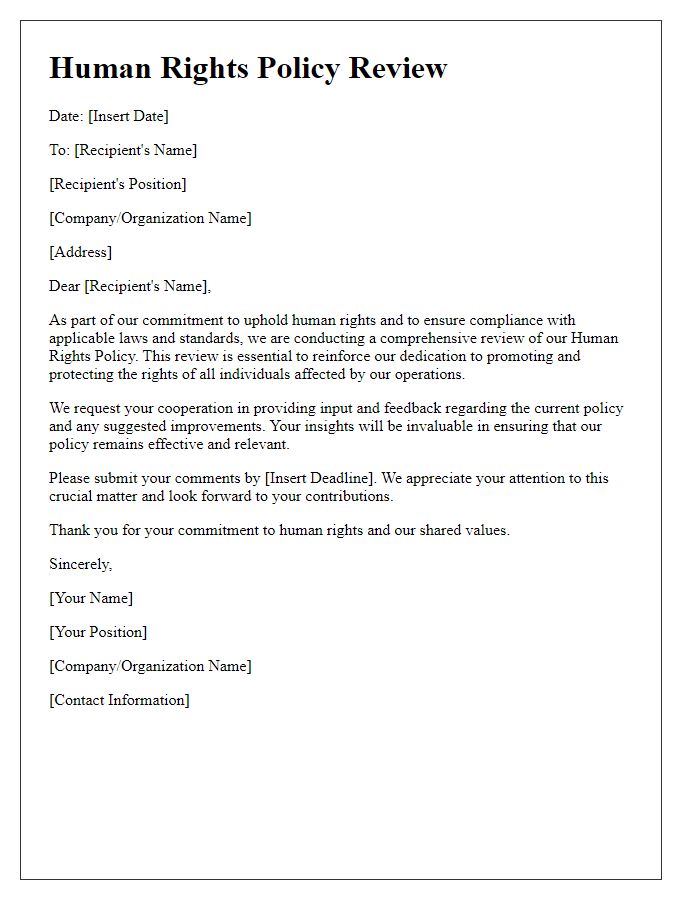Are you ready to dive into the world of human rights compliance? In this article, we'll explore the essential elements of crafting a letter template designed to ensure your organization's commitment to uphold human rights standards. By highlighting key principles and including actionable steps, you can effectively communicate your dedication to fostering a culture of respect and accountability. So, let's get started and uncover the tools you need to make a meaningful impactâread on for more!

Legal framework and international standards
The global legal framework for human rights compliance includes prominent documents such as the Universal Declaration of Human Rights, adopted by the United Nations General Assembly in 1948, which outlines fundamental human rights applicable universally. Various international treaties, like the International Covenant on Civil and Political Rights and the International Covenant on Economic, Social and Cultural Rights, establish binding obligations for state parties. Regional instruments, exemplified by the European Convention on Human Rights, further enhance compliance mechanisms by providing avenues for individuals to seek justice. The role of non-governmental organizations, such as Amnesty International and Human Rights Watch, is crucial in monitoring adherence to international standards and advocating for accountability. Key international bodies, including the Human Rights Council and various treaty monitoring committees, evaluate states' compliance through periodic reviews and reporting mechanisms, aiming to address violations and ensure protection of rights.
Human rights assessment and due diligence
Human rights assessments are essential for organizations committed to ensuring compliance with international human rights standards. Conducting thorough due diligence involves evaluating potential human rights impacts for stakeholders, such as employees, communities, and supply chains. Key frameworks, like the United Nations Guiding Principles on Business and Human Rights, provide guidelines for identifying risks, mitigating adverse effects, and promoting positive human rights practices. Organizations may implement periodic assessments at various operational locations, including factory sites and corporate offices, ensuring consistent engagement with affected groups. Reporting findings in transparency initiatives can foster accountability, enhance stakeholder trust, and align operational strategies with ethical principles. Integrating human rights considerations into corporate governance strengthens an organization's commitment to sustainable practices.
Stakeholder engagement and consultation
Stakeholder engagement in human rights compliance involves meaningful dialogue with affected groups, such as local communities and human rights organizations. This process encourages transparency and accountability, fostering trust. In 2021, the United Nations Guiding Principles on Business and Human Rights emphasized the need for organizations to prioritize stakeholder perspectives. Regular consultations, ideally quarterly, ensure ongoing feedback and adaptation. Tools like surveys, focus groups, and public forums can reveal significant insights into community concerns. In regions with historical human rights issues, such as Southeast Asia, active engagement is crucial to prevent violations and build stronger relationships with local populations.
Monitoring, reporting, and transparency mechanisms
Monitoring human rights compliance requires robust mechanisms to ensure accountability and transparency. Independent bodies often employ systematic assessments, including the Universal Periodic Review conducted by the United Nations, which evaluates the human rights records of member states every four years. Reporting frameworks, such as the Human Rights Reporting System utilized by various non-governmental organizations, gather data on human rights violations and promote public awareness. Transparency initiatives, like the Open Government Partnership launched in 2011, encourage governments to disclose information related to human rights practices, fostering civic engagement. In jurisdictions such as the European Union, the Charter of Fundamental Rights holds member states accountable, aligning national legislation with international human rights standards, thus promoting a culture of compliance and protection for individuals facing discrimination or abuse.
Remediation and grievance processes
Human rights compliance in organizations necessitates effective remediation and grievance processes, which serve to address violations and concerns. Entities must establish transparent mechanisms, accessible to all stakeholders, for reporting grievances--ensuring confidentiality and protection against retaliation. An effective process includes multiple channels for reporting, such as online platforms or dedicated hotline numbers, accommodating individuals from diverse backgrounds. Timely investigation of complaints within specified timeframes promotes accountability. Organizations should also implement follow-up procedures, offering updates to complainants and documenting resolutions. Regular training sessions on human rights principles further enhance awareness, fostering a culture of respect. Establishing partnerships with local human rights organizations can provide additional support and resources, ensuring comprehensive compliance with international standards.













Comments